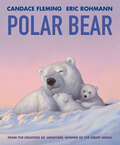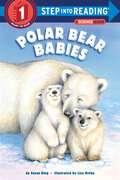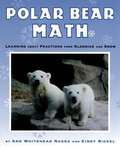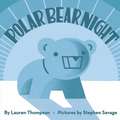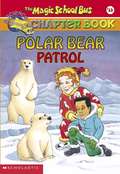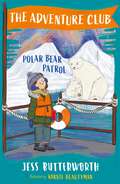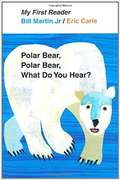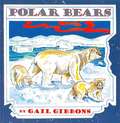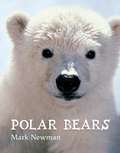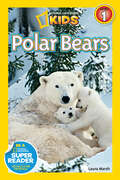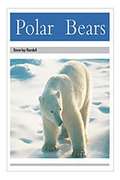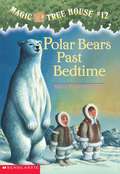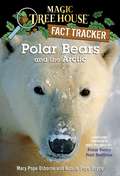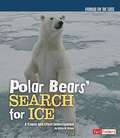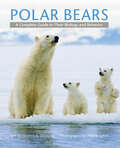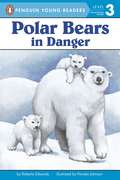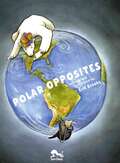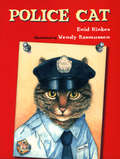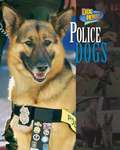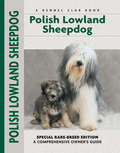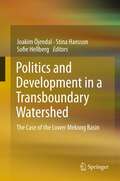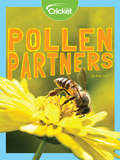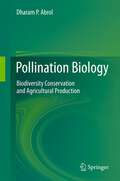- Table View
- List View
Polar Bear
by Candace FlemingThis companion book to the authors&’ Sibert award-winning Honeybee explores the life and habitat of a majestic endangered species through dramatic text and sumptuous illustration.April in the Arctic . . .Cold winds send snow clouds scuttling across the sky.Temperatures barely nudge above freezing.But every now and again,The cloud cover parts,The sun shines down,And the frozen world stretches awake. As spring approaches in the Arctic, a mother polar bear and her two cubs tentatively emerge from hibernation to explore the changing landscape. When it is time, she takes her cubs on a forty-mile journey, back to their home on the ice. Along the way, she fends off wolves, hunts for food, and swims miles and miles. This companion book to Honeybee and Giant Squid features the unique talents of Fleming and Rohmann on a perennially popular subject. Eric Rohmann's magnificent oil paintings feature (as in Honeybee) a spectacular gatefold of the polar landscape.A Junior Library Guild Gold Standard Selection
Polar Bear Babies (Step into Reading)
by Susan RingIn this Step 1 Step into Reading Science Reader, polar bear babies learn the skills they will need to survive in the Arctic! Simple, repetitive text takes readers through a day with these little bears as they learn to fish, swim, and . . . run! Sweet, approachable art and a touch of excitement make this an ideal reader for curious little animal enthusiasts. Step 1 Readers feature big type and easy words. Rhymes and rhythmic text paired with picture clues help children decode the story. These books are for children who know the alphabet and are eager to begin reading.
Polar Bear Math: Learning About Fractions from Klondike and Snow
by Ann Whitehead Nagda Cindy Bickel<p><i>That night Cindy took the tiny cubs home with her. She didn't sleep at all-she was too busy feeding milk to the twins, cleaning them, and checking on every little cry. When dawn came, the small bears were still clinging to life.</i> <p>Children learn about fractions while following the Denver Zoo's baby polar bears, Klondike and Snow <p>Early one morning at the Denver Zoo, a polar bear gives birth to two tiny babies, then abandons them. <p>The zoo staff must raise the babies, but there are many things they don't know. What foods are best? How much should the cubs eat? Once they figure out the answers, the cubs quickly become healthy, happy young bears. <p>Young readers follow Klondike and Snow as they grow from fragile newborns to large, lively bears, and along the way they'll learn about fractions.</p>
Polar Bear Night
by Lauren ThompsonAfter wandering out at night to watch a magical star shower, a polar bear cub returns home to snuggle with her mother in their warm den.
Polar Bear Patrol (Magic School Bus #13)
by Judith Bauer Stamper Steve Haefele Judith Bauer-StamperGet ready for some serious science fun when the Friz takes the kids on a chilling adventure through the North Pole! Hi, I'm Tim -- one of the kids in Ms. Frizzle's class. When Ms. Frizzle announced that we'd be studying the North Pole, I never thought it would lead us to the top of the world. I also never thought I'd get to see seals, caribou, musk oxen, and polar bears in person, but that was just the beginning. Find out all the bone-chilling facts of our Arctic adventure!
Polar Bear Patrol: Book 3 (The Adventure Club #3)
by Jess ButterworthDo you like exploring, animals and adventure? Then join The Adventure Club! A new illustrated series for younger readers about animals and adventure from much-loved author Jess Butterworth - writer of classic adventure stories in vibrantly described settings.It's time for the third Adventure Club trip, and this time Tilly and the Adventure Club are off to the Arctic circle in search of polar bears! There, they journey across the ice on sleighs pulled by huskies, camp in tents, and watch the northern lights, braving sub-zero temperatures. But on a boat trip, disaster strikes! The team find a narwhal caught in a fishing net. It's a race against time to free the narwhal. Will they succeed? And will the Adventure Club team spot a single polar bear before they have to leave?Join the Adventure Club with Tilly to find out!Packed full of illustrations and set as Tilly's own diary, this new series is perfect for young readers who are beginning to read on their own.
Polar Bear, Polar Bear, What Do You Hear? (My First Reader)
by Bill Martin<p>What will you hear when you read this book to a preschool child? <p>Lots of noise! <p>Children will chant the rhythmic words. They'll make the sounds the animals make. And they'll pretend to be the zoo animals featured in the book-- look at the last page! <p>Bill Martin Jr. and Eric Carle are two of the most respected names in children's education and children's illustrations. This collaboration, their first since the classic Brown Bear, Brown Bear, What Do You See? (published more than thirty years ago and still a best-seller) shows two masters at their best.</p>
Polar Bear, Why Is Your World Melting?
by Robert E WellsIn the Arctic, the summer ice is melting, making it hard for polar bears and their cubs to survive. Why is the world getting warmer? The heat of the sun is trapped by the "greenhouse" gases that surround Earth--carbon dioxide, methane, nitrous oxide, and water vapor. If there is just the right amount of these trapped gases, the air is warm enough for plants, animals, and people to thrive. But now there is too much greenhouse gas, especially carbon dioxide. Polar bears, and all of us, are in trouble. Robert E. Wells, who lives in Washington State, shows why so much carbon dioxide is going into the air and what we can do to help keep Earth cool.
Polar Bears
by Gail GibbonsThe polar bear is the biggest and most powerful of the animals that are able to survive the hostile climate of the Arctic. Cubs are born during the cold dark winter, even though they start out with only a thin coat of fur and weigh a little over one pound. The mothers raise and teach them so they may grow and survive in the wild. Here is information about how polar bears swim and hunt, how they keep warm and dry, and the many other ways they adapt to their environment.
Polar Bears
by Mark NewmanAn interesting insight into facts and life of polar bears, both on land and under water, explained by renowned wild life photographer Mark Newman.
Polar Bears (Nature's Children)
by Caroline GreenlandDescribes the physical features, habits, and natural environment of the Nanook, Ice Bear or more commonly known as The Polar Bear.
Polar Bears (Readers)
by Laura MarshWith their beautiful white fur and powerful presence, polar bears rule the Arctic. These majestic giants swim from iceberg to iceberg in chilling waters, care for their adorable cubs, and are threatened by global warming. In this level 1 reader you'll learn all you ever wanted to know about polar bears and so much more. Complete with fascinating facts and beautiful images, National Geographic Readers: Polar Bears can't miss.
Polar Bears (Rigby PM Collection Ruby (Levels 27-28), Fountas & Pinnell Select Collections Grade 3 Level Q)
by Beverley RandellPolar Bears by Beverley Randell
Polar Bears Past Bedtime (Magic Tree House #12)
by Mary Pope Osborne"It's icicle city when the Magic Tree House whisks Jack and Annie to the frozen Arctic. Luckily, a seal hunter on a dogsled lends them warm clothes. Unluckily, they get stuck on cracking ice. Will the giant polar bear save them? Or will Jack and Annie become frozen dinners?" Brrrr! Kids! Don't miss Jack's Arctic Facts! And, if you enjoyed this book, read other Magic Tree House books available from Bookshare.
Polar Bears and the Arctic: A Nonfiction Companion to Magic Tree House #12: Polar Bears Past Bedtime (Magic Tree House Fact Tracker #16)
by Mary Pope Osborne Sal Murdocca Natalie Pope BoyceMagic Tree House Research Guides are now Magic Tree House Fact Trackers! Track the facts with Jack and Annie! When Jack and Annie got back from their adventure in Magic Tree House #16: Polar Bears Past Bedtime, they had lots of questions. Why is the Arctic so cold? What did the first people of the Artic eat? How do polar bears cross thin ice? What other animals live in the Arctic? Find out the answers to these questions and more as Jack and Annie track the facts. Filled with up-to-date information, photos, illustrations, and fun tidbits from Jack and Annie, the Magic Tree House Fact Trackers are the perfect way for kids to find out more about the topics they discovered in their favorite Magic Tree House adventures.From the Trade Paperback edition.
Polar Bears' Search for Ice: A Cause and Effect Investigation (Animal's on the Edge)
by Gillia M. OlsonPolar bears are losing their Arctic homes. As the Arctic ice shrinks, so does their habitat. Polar bears have become animals on the edge. Discover how scientists are trying to answer the questions behind polar bears' search for ice.
Polar Bears: A Complete Guide to Their Biology and Behavior
by Andrew E. DerocherHonorable Mention, 2012 National Outdoor Book AwardsThe polar bear, king of the Arctic, is one of the world’s most recognizable animals. Images of the majestic beasts roaming across the ice cap, plunging into frigid waters, and playing with furry cubs have come to symbolize the beauty and grandeur of the Arctic. Andrew E. Derocher and Wayne Lynch have spent decades following the bears, and this book offers the most comprehensive and readable review of their biology, ecology, behavior, and conservation.With gripping photographs by Lynch, a preeminent wildlife photographer, and the personal stories of Derocher, this book is as stunning to look at as it is fascinating to read. It weaves together their remarkable experiences with the latest research to tell the amazing story of these Arctic predators, tracing the animals back to their evolutionary roots and looking ahead to the future of polar bears on a warming planet Earth.Through informative and engaging language, Derocher carefully explains the sea ice ecosystem that is essential to the survival of polar bears. He addresses the threat of global warming to the Arctic—home to polar bears for tens of thousands of years—and describes in impressive detail their feeding habits, distribution, den ecology, and reproduction. Lynch’s vivid photographs capture all this and more as they chronicle the wide range of polar bear behavior, from family rituals to ferocious predatory practices. Captivating, accurate, and inspiring, Polar Bears belongs in the hands of all who love the wild.
Polar Bears: In Danger
by Pamela Johnson Roberta EdwardsDid you know that a full-grown polar bear standing on his hind legs is as tall as an elephant? Polar bears are one of nature's most beautiful animals, but their home'the Arctic North'is in danger. Kids will love learning about these Arctic animals and finding out more about global warming.
Polar Opposites
by Erik BrooksAlex is a BIG polar bear. Zina is a tiny penguin. Alex lives in the Arctic. Zina lives in the Antarctic. Alex and Zina are polar opposites! They live on opposite sides of the world. Their personalities are very different, too. But they find a way to meet in the middle. Erik Brooks’s simple text and vibrant watercolor illustrations bring opposites to life in this lively look at two unusual best friends.
Police Cat
by Wendy Rasmussen Enid HinkesNoodles wants to be an official member of the police department more than anything. But the rules won't allow cats on the squad, even if Noodles is the best rat-chaser in the city. Still, Noodles goes out every night and patrols the streets. One night he comes upon a pack of rats that are up to no good. While chewing wires the rats start a fire in a basement. Noodles gets into the house and wakes the sleeping children. The whole family escapes and Noodles is a hero. But, wait--Truman, the police dog with the K-9 unit, gets the credit. Will the rescued family set the record straight?
Police Dogs
by Frances E. RuffinIn hot pursuit, Sipo senses the criminal is nearby. Suddenly--Caught! Sipo got his man. Sipo is a police dog that works as part of a K-9 team with a police officer. Young readers will meet Sipo and other police dogs in this fast-paced, informative narrative of dogs trained to sniff out criminals. Young readers will discover the fascinating details of daily police work, and learn how man and dog work together to pursue criminals and solve crimes. With vivid four-color photos and exciting case studies from the files of your local police department Police Dogs proves once again that crime doesn't pay.
Polish Lowland Sheepdog
by Mary Bloom Betty AugustowskiThe Polish Lowland Sheepdog, known in its homeland as the Polski Owczarek Nizinny, ranks as one of the world's most irresistible shaggy dogs. The PON (named for the acronym of its Polish name) is in fact a talented, biddable herding dog whose skills and tousled cuteness continue to "pen" new admirers in every dog-loving country of the world. The PON's delightful personality shines in his ever-present smile and clever ways. For an owner seeking a smart, entertaining and cheery canine companion, the Polish Lowland Sheepdog promises to brighten your world day in and day out. The author of this volume, PON authority and American breed pioneer Elizabeth Augustowski, was honored by the Polish Kennel Club for her contributions to the breed. This new full-color book offers a concise history of the breed in both Europe and America and paints a colorful portrait of the breed's characteristics through anecdotes and photographs. The author discusses the breed standard and how to evaluate a PON, information useful for newcomers selecting a puppy or experienced breeders and judges. This Special Rare-Breed Edition also offers reliable information on PON puppy care, house-training and basic obedience, helping readers better understand this lively, lovable herding dog. An authoritative, up-to-date chapter on canine healthcare, written by Dr. Lowell Ackerman, completes the package, making this volume both comprehensive and indispensable.
Politics and Development in a Transboundary Watershed
by Joakim Öjendal Sofie Hellberg Stina HanssonWater - and its governance - is becoming a global concern partly because it is turning into a goods in short supply, with devastating effects on literally billions of people, but also because it is the "carrier" of global warming; whether through irregular weather patterns or through flooding, water is how global warming will be 'felt'. The lion's share of the globally available fresh water resources is to be found in transboundary systems. In spite of its significance, the generated knowledge on how to deal with transboundary waters is weak and leaves policy makers with seemingly unavoidable, trade-off dilemmas and prioritizations, often with detrimental effects. In order to disentangle this predicament this volume works with one case: the Lower Mekong Basin and covers state-of-the-art academic and practitioners' knowledge and hence appeals to a wide audience. The topic this volume addresses is situated in the nexus of an IR- (International Relations) approach focussing on transboundary politics and its inclination to remain within the sphere of state sovereignty and national interest on the one hand, and Development studies, with its imperatives on participation, planning, and intervention, on the other. The dilemma, we argue, of better understanding transboundary water management lies in how to understand how these two rationalities can be simultaneously nurtured. Audience: This book will be relevant to scholars, as it provides cutting-edge research, and students, since it covers the primary debates in the field, interested in resource management, regional politics, and development issues in the area. It also addresses the global debate on transboundary water management and presents an in-depth case of one of the globally most sophisticated attempts at pursuing sustainable river basin management. Finally, practitioners and policymakers would benefit greatly because all contributions have explicit policy relevance, launching suggestion on improvements in water management.
Pollen Partners
by Amy TaoDo you know how new flowers are made? It’s a process called pollination, which is what happens when pollen is moved from one flower to another! The flowers rely on animals like bees and hummingbirds to do this for them, and in return, they offer the animals delicious nectar to eat. What is your favorite pollen-moving animal?
Pollination Biology
by Dharam P. AbrolThis book has a wider approach not strictly focused on crop production compared to other books that are strictly oriented towards bees, but has a generalist approach to pollination biology. It also highlights relationships between introduced and wild pollinators and consequences of such introductions on communities of wild pollinating insects. The chapters on biochemical basis of plant-pollination interaction, pollination energetics, climate change and pollinators and pollinators as bioindicators of ecosystem functioning provide a base for future insights into pollination biology. The role of honeybees and wild bees on crop pollination, value of bee pollination, planned honeybee pollination, non-bee pollinators, safety of pollinators, pollination in cages, pollination for hybrid seed production, the problem of diseases, genetically modified plants and bees, the role of bees in improving food security and livelihoods, capacity building and awareness for pollinators are also discussed.
